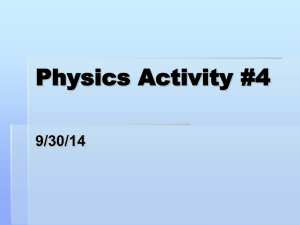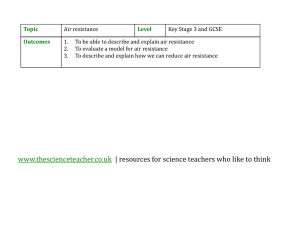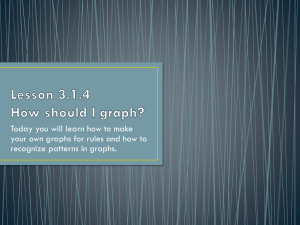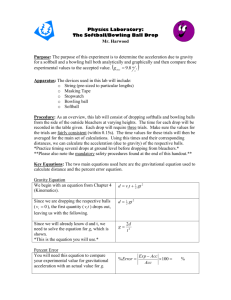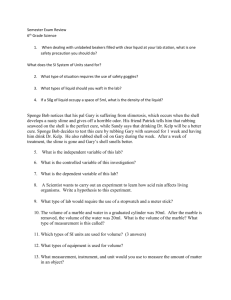PHYSICAL SCIENCE Chapter 1: The Nature of Science
advertisement
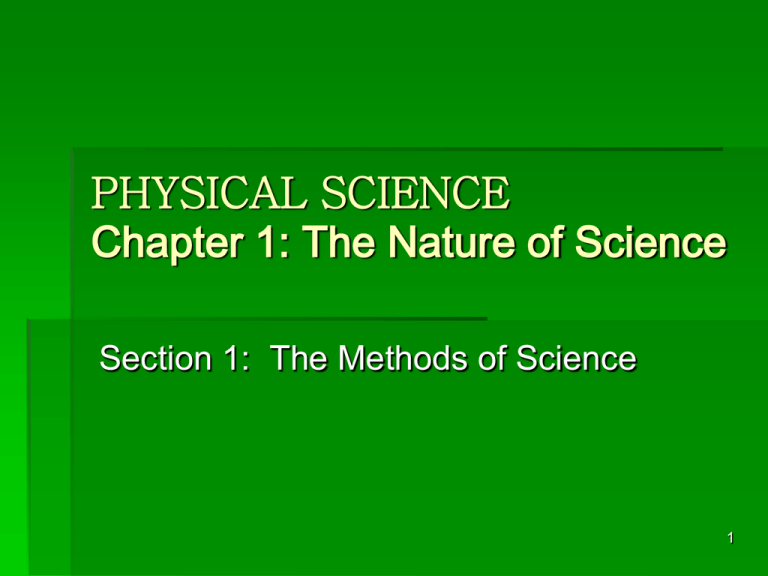
PHYSICAL SCIENCE Chapter 1: The Nature of Science Section 1: The Methods of Science 1 What is science? The term science is derived from the latin word scientia, meaning “knowledge.” 2 There are 3 Major Categories of Science 1. Earth science— 7th grade— investigates Earth and space 2. Life science—8th grade—deals with living things 3. Physical science—9th grade— study of matter and energy 3 The Scientific Method An organized set of investigation procedures is called the scientific method. 4 STEP 1 STATE THE PROBLEM (after making observations) The problem is often stated in the form of a question (Why…? How…?) 5 STEP 2 RESEARCH AND GATHER INFORMATION Learn about the background of the problem. What other tests have scientists already performed? 6 STEP 3 FORM A HYPOTHESIS—A hypothesis is a possible explanation for a problem. “Educated Guess” Prediction 7 STEP 4 TESTING A HYPOTHESIS Make observations Build a model Perform an experiment 8 STEP 5 ANALYZE THE DATA—Record observations into easy-to-read tables and graphs. Include all results, even unexpected ones. (NO BIAS) 9 STEP 6--DRAW A CONCLUSION—Is your hypothesis supported or not? SUPPORTED— REPEAT steps 4-6 several times NOT SUPPORTED— REPEAT STEPS 3-6 (if now supported, see above) 10 VARIABLES A variable is a quantity that can have more than a single value. An experiment usually contains at least 2 variables. 11 EXPERIMENT Which brand of fertilizer helps plants to grow the biggest? 12 List variables—factors that might cause plants to grow bigger. Amount of sunlight Amount of water Type of fertilizer Type of soil Room temperature Plant type 13 What is the independent variable? The variable you change to see how it will affect the dependent variable. The scientist is able to choose the independent variable. Ex. The brand of fertilizer 14 What is the dependent variable? The dependent variable changes according to the changes in the other variable. The scientist is not able to choose the dependent variable. Ex. The amount of plant growth 15 Constants A constant is a factor that does not change when other variables change. Constants remain the same throughout the experiment. Examples—amount of sunlight, amount of water, room temperature, type of soil, plant type 16 Control A control is the standard by which the test results can be compared. One plant has no fertilizer. This plant is the control. Ex. Three fertilized plants grow between 2-3 cms. VS. The unfertilized plant grows 1.5 cms. 17 Are science and technology the same? Science is acquiring knowledge. Technology is the application of science to help people. Sweet 80’s Picture 18 CHAPTER 1: THE NATURE OF SCIENCE Section 2: Standards of Measurement 19 A standard is an exact quantity that people agree to use for comparison. English Measurement System (U.S.A.) Milkgallon Lumberfoot Potatoespound Metric (Other Nations) Based on multiples of 10 and developed in the late 1700’s. Milk→ Liter Lumber→Meter Potatoes→ Kilogram 20 In 1960, an improved version of the metric system was devised, known as the International System of Units, abbreviated SI. SI BASE UNITS QUANTITY MEASURED UNIT SYMBOL Length Mass Time Temperature meter kilogram second kelvin m kg s K 21 SI PREFIXES are easy to use, because they are based on multiples of 10. The prefix kilomeans “1,000” The prefix decimeans “one-tenth” 1 kilometer = 1,000 meters 1 kilogram = 1,000 grams 1 decimeter = one-tenth of a meter (0.1 m) 1 decigram = one-tenth of a gram (0.1 g) 22 COMMON SI PREFIXES PREFIX SYMBOL Kilo- k MULTIPLYING FACTOR 1,000 Hecto- h 100 Deca- da 10 BASE UNIT BASE UNIT BASE UNIT Deci- d 0.1 Centi- c 0.01 Milli- m 0.001 23 CONVERTING BETWEEN SI UNITS Conversion factors are used to change one unit to another. A conversion factor is a ratio that is equal to one. Ex. 1,000 mL = 1 L CF 1,000 mL = 1 1L OR 1L =1 1,000 mL 1,000 mL 1L = 1L 1L 24 To convert units, you multiply by the appropriate conversion factor. Ex. 1.255 L = ? mL 1.255 L x 1,000mL = 1L 1,255 mL 25 MEASURING DISTANCE The SI unit of length is the meter, m. Length is measured as the distance between 2 points. 26 The size of the unit you measure with will depend on the size of the object being measured. Distance from home to school = km Length of your pencil = cm 27 MEASURING VOLUME The amount of space occupied by an object is called its volume. (Solids, liquids, and gases) 28 Ex. VOLUME OF A BOX Measure its length, width, height Multiply the 3 numbers and add their units together V = l x w x h V = 13 cm x 5 cm x 3 cm V = 195 cm3 29 Measuring Matter Mass is a measurement of the quantity of matter in an object. A table-tennis (ping pong) ball and a golf ball have about the same volume. The golf ball has more mass. 30 The mass of a golf ball is almost 18 times the mass of a ping pong ball. GOLF BALL = 45 g PING PONG BALL = 2.5 g 31 DENSITY Cube of Aluminum vs. Cube of Copper Same SIZE Different MASS Same VOLUME Different DENSITY WHAT IS DENSITY? 32 Density is the mass per unit volume of a material. Density (D) = mass (m) volume (v) D = 10 g 2 cm3 D = 5 g/cm3 The measurement unit for density, g/cm3, is a combination of SI units. A unit obtained by combining different SI units is called a derived unit. 33 TIME Time is the interval between 2 events. The SI unit for time is the second. 34 TEMPERATURE For most scientific work, temperature is measured on the Celsius (C) scale. The SI unit of temperature is the kelvin (K). 35 THE 3 TEMPERATURE SCALES FREEZING POINT OF WATER 0°C, 32°F, or 273K BOILING POINT OF WATER 100°C, 212°F, or 373K 36 Converting Fahrenheit (F) to Celsius (C) Ex. 70°F = ? °C C = 5(F-32) 9 C = 5(70-32) 9 C = 5(38) 9 C = 190 9 C = 21.1 or 21°C 37 CONVERTING CELSIUS (C) TO FAHRENHEIT (F) Ex. 21°C = ? °F °F = 32 + (9x°C) 5 °F = 32 + (9x21) 5 °F = 32 + 189 5 °F = 32 + 37.8 °F = 69.8 or 70°F 38 CHAPTER 1: THE NATURE OF SCIENCE Section 3—Communicating with Graphs 39 A VISUAL DISPLAY Scientists often graph the results of their experiments because they can detect patterns in the data easier in a graph than in a table. A graph is a visual display of information or data. Why are graphs important? Graphs are a quick way to communicate a lot of information in a small amount of space. 40 There are 3 types of graphs--line, bar, and circle (pie). Line graphs show how a relationship between variables changes over time. 41 Bar Graphs A bar graph is useful for comparing information collected by counting. 42 Circle Graphs A circle graph or pie graph is used to show how some fixed quantity is broken down into parts. The circular pie represents the total. The slices represent the parts (percentages of the total). 43
